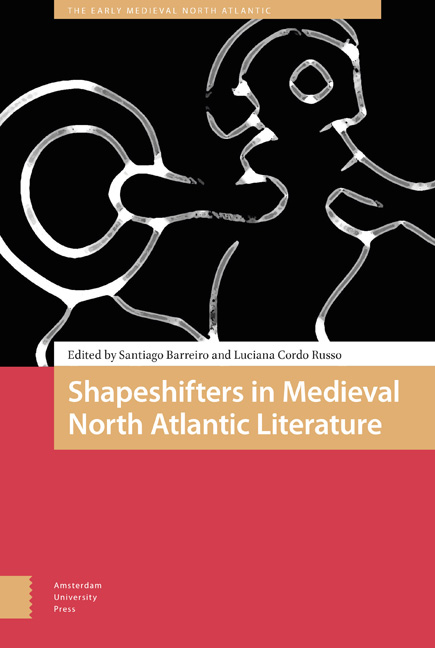Book contents
- Frontmatter
- Contents
- Acknowledgments
- Introduction: Medieval Thought and Shapeshifting
- 1 Wundor wearð on wege‘a wonder happened on the way’: Shifting shapes and meanings in Old English Riddles
- 2 The Big Black Cats of Vatnsdalr and Other Trolls: Talking about shapeshifting in medieval Iceland
- 3 The Hoard Makes the Dragon: Fáfnir as a Shapeshifter
- 4 Eigi í mannligu eðli: Shape, Monstrosity and Berserkism in the Íslendingasögur
- 5 The Cursed and the Committed: A Study in Literary Representations of ‘Involuntary’ Shapeshifting in Early Medieval Irish and Old Norse Narrative Traditions
- 6 Unde sunt aues istae?: Notes on Bird-Shapeshifting, Bird Messengers, and Early Medieval Hagiography
- 7 Sin, Punishment, and Magic: Changing Form in Medieval Welsh Literature
- Index
4 - Eigi í mannligu eðli: Shape, Monstrosity and Berserkism in the Íslendingasögur
Published online by Cambridge University Press: 16 February 2021
- Frontmatter
- Contents
- Acknowledgments
- Introduction: Medieval Thought and Shapeshifting
- 1 Wundor wearð on wege‘a wonder happened on the way’: Shifting shapes and meanings in Old English Riddles
- 2 The Big Black Cats of Vatnsdalr and Other Trolls: Talking about shapeshifting in medieval Iceland
- 3 The Hoard Makes the Dragon: Fáfnir as a Shapeshifter
- 4 Eigi í mannligu eðli: Shape, Monstrosity and Berserkism in the Íslendingasögur
- 5 The Cursed and the Committed: A Study in Literary Representations of ‘Involuntary’ Shapeshifting in Early Medieval Irish and Old Norse Narrative Traditions
- 6 Unde sunt aues istae?: Notes on Bird-Shapeshifting, Bird Messengers, and Early Medieval Hagiography
- 7 Sin, Punishment, and Magic: Changing Form in Medieval Welsh Literature
- Index
Summary
Abstract
The berserkir of Old Norse literature have been argued to be able to transform into wolves or bears when berserksgangr, or battle rage, is upon them. However, while an animalistic association cannot be denied, not all genres of saga literature depict berserkir as true shapechangers. This, however, does not mean that they are not ontologically ambiguous — that they are not monstrous. Reading the berserkir of the Íslendingasögur through the lens of monster theory offers a new perspective on this much-studied character type that reveals that, rather than being physically hybrid, they are socially disruptive: especially in their relationships with women, berserkir in the Íslendingasögur reveal their monstrosity. Ultimately, this reading contributes both to our understanding of berserkir, and to our knowledge of their place in the medieval Icelandic imagination.
Keywords: Íslendingasögur; berserkir; monstrosity; monster studies
Of all the paranormally connoted opponents a hero can face in medieval Icelandic literature, the berserkr is one of the most frequently appearing monstrous antagonists. The chances of encountering one are equally high in the fornaldarsögur and the Íslendingasögur, and beyond these genres they appear in Heimskringla, Snorra Edda and both eddic and skaldic poetry. In addition to these high and late medieval narratives, scholars have found them reflected in diverse sources from antiquity to the Viking Age, ranging from Tacitus’s Germania to Migration Age bracteates and Viking Age rune stones. Drawing on all of these sources, scholars have tried to paint a coherent and cohesive picture of these inconsistently depicted figures, arguing for instance that they reflect remnants of Odinic Männerbünde, or of human-animal shapeshifting. It is this latter concept that this article will focus on, trying to revise some of the assumptions that have been made about berserkir and their relationship to shapeshifting and monstrosity.
One of the problems of previous work on berserkir is that, in many cases, scholars do not adequately differentiate between berserkir appearing in different genres of saga literature. It is, however, important to distinguish between different kinds of berserkir: in the fornaldarsögur, for example, some berserkir can change shape physically, whereas — as I will argue below — this does not happen in the Íslendingasögur.
- Type
- Chapter
- Information
- Shapeshifters in Medieval North Atlantic Literature , pp. 83 - 106Publisher: Amsterdam University PressPrint publication year: 2018
- 1
- Cited by



